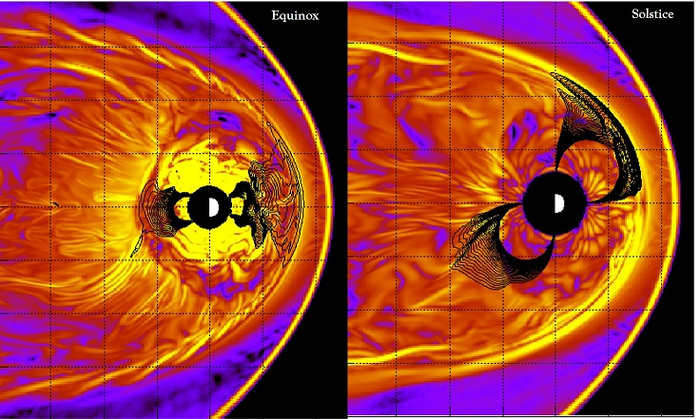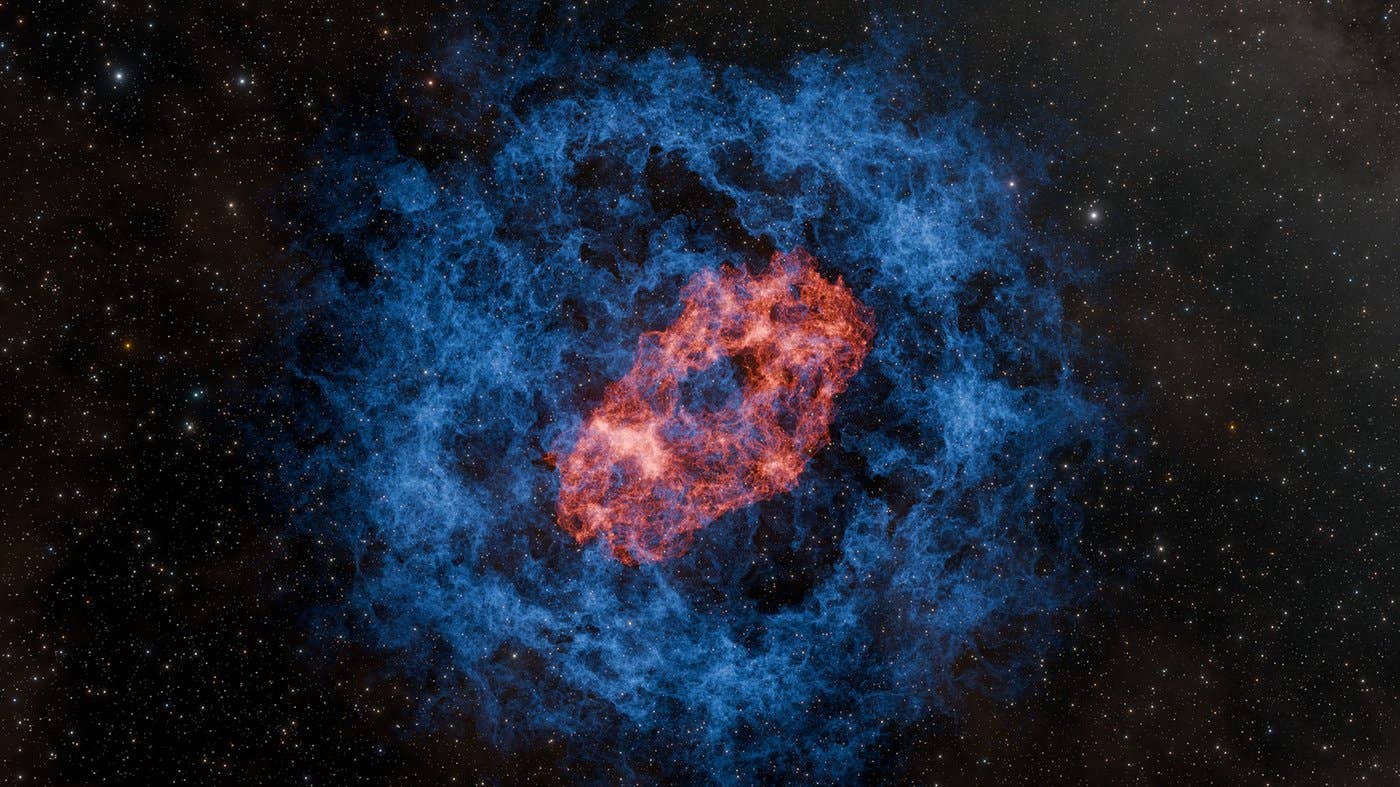‘Space waves’ offer new clues to understanding space weather
Researchers have uncovered new insights into “space waves,” which could lead to more accurate space-weather predictions and improved safety.

[May 7, 2023: Staff Writer, The Brighter Side of News]
When solar wind hits the magnetosphere, it creates breaking waves known to scientists as Kelvin-Helmholtz waves. This wave activity is seasonal, researchers found; it increases around the spring and fall seasons (equinoxes) and decreases around summer and winter (solstices). (CREDIT: S. Kavosi and H. Nykyri / Embry-Riddle Aeronautical University)
Embry-Riddle Aeronautical University researchers have uncovered new insights into "space waves," which could lead to more accurate space-weather predictions and improved safety for satellite navigation through radiation belts.
Their findings, published in the journal Nature Communications, reveal that the Earth's magnetic tilt has a significant impact on large-wavelength space waves, with seasonal and daily variations affecting their occurrence.
Kelvin-Helmholtz (KH) waves, the breaking space waves in question, form at the boundary between the solar wind and Earth's magnetic shield. They are more prevalent during the spring and fall seasons, while wave activity diminishes during summer and winter.
As the solar wind, consisting of plasma, streams from the Sun at speeds reaching 1 million miles per hour, it carries energy, mass, and momentum towards Earth's magnetic shield, generating space waves in the process.
Related Stories
The fast-moving solar wind is unable to pass directly through Earth's magnetic shield, so it races along the magnetosphere, driving KH waves with peaks as high as 15,000 kilometers and lengths of up to 40,000 kilometers. These waves have significant implications for both astronaut safety and satellite communication, as they can lead to fluctuations in radiation belt fluxes of energetic particles—dangerous radiation regions.
Dr. Shiva Kavosi, a research associate at Embry-Riddle and the first author of the Nature Communications paper, explained that space waves impact power grids and Global Positioning Systems on Earth in addition to affecting astronauts and satellites. Understanding the properties of space waves and the mechanisms that intensify them is crucial for predicting and managing space weather.
Astronaut Safety and Satellite Communication
“Through these waves, solar wind plasma particles can propagate into the magnetosphere, leading to variations in radiation belt fluxes of energetic particles—regions of dangerous radiation—that may affect astronaut safety and satellite communications,” said Dr. Shiva Kavosi, a research associate at Embry-Riddle and first author of the “Nature Communications” paper. “On the ground, these events can impact power grids and Global Positioning Systems.”
Schematic Sun–Earth geometry and seasonal and diurnal variations of the angles φ and θ. (CREDIT: Nature Communications)
Researchers in the field have proposed several hypotheses to explain the seasonal and diurnal variations of geomagnetic activity. One such hypothesis, the Russell-McPherron (R-M) effect, first described in 1973, explains the increased frequency and brightness of auroras during spring and fall, based on the interaction between Earth's dipole tilt and a small magnetic field near the Sun's equator.
“We don’t have all the answers yet,” said Dr. Katariina Nykyri, professor of physics and associate director for the Center of Space and Atmospheric Research at Embry-Riddle, “but our paper shows that the R-M effect is not the only explanation for the seasonal variation of geomagnetic activities. Equinox-driven events, based on the Earth’s dipole tilt, and R-M effects could operate simultaneously.”
Time-of-year-time-of-day (Y-UT) plots. Of a cos2(φ), the equinoctial effect, b sin2(θ), the RM effect, [−(B2Isin2(θ) + B2Msin2(φ))] for c BM = 2BI and d BM = 3BI, respectively, with red showing when the stabilizing term is minimum, i.e., the growth rate is maximum. e KHI occurrence rates for one solar cycle data. (CREDIT: Nature Communications)
Nykyri envisions that future constellations of spacecraft in the solar wind and magnetosphere could help clarify the complex, multi-scale physics of space weather phenomena. Such a system would enable advanced warnings of space weather, benefiting operators of rocket launches and electrical power grids.
What effects do 'space waves' have on Earth?
Space waves can have several effects on Earth and its surrounding environment. These waves form at the boundary between the solar wind and Earth's magnetic shield, and their interactions can influence space weather and various systems on our planet. Some of the primary effects of space waves on Earth include:
Impact on satellite communications: Space waves can lead to variations in radiation belt fluxes of energetic particles, which may disrupt satellite communication systems. These disruptions can affect various services such as television broadcasting, internet connectivity, and global positioning systems (GPS).
Astronaut safety: The fluctuations in radiation belt fluxes due to space waves can create regions of dangerous radiation, posing a threat to astronaut safety during space missions.
Aurora activity: Space waves can contribute to the intensification of geomagnetic activity and auroras, the natural light displays known as the Northern and Southern Lights. These phenomena are caused by charged particles from the solar wind interacting with Earth's magnetic field and atmosphere.
Power grid disturbances: Geomagnetic activity associated with space waves can induce electric currents in the Earth's crust, which can affect power transmission lines and potentially lead to blackouts or damage to electrical infrastructure.
Impact on pipelines and other infrastructure: The electric currents induced by geomagnetic activity can cause corrosion in pipelines and other underground metallic structures, leading to reduced efficiency and increased maintenance costs.
Understanding and predicting the effects of space waves can help mitigate their impacts on Earth by allowing us to better prepare for potential disruptions in satellite communications, power grids, and other critical systems.
The Nature Communications paper concludes that "KH waves activity exhibit seasonal and diurnal variations, indicating the critical role of dipole tilt in modulating KHI across the magnetopause as a function of time."
This groundbreaking research provides a foundation for further advancements in space-weather predictions and satellite safety, ultimately benefiting our understanding of the universe and its impact on our daily lives.
Note: Materials provided above by The Brighter Side of News. Content may be edited for style and length.
Like these kind of feel good stories? Get the Brighter Side of News' newsletter.



